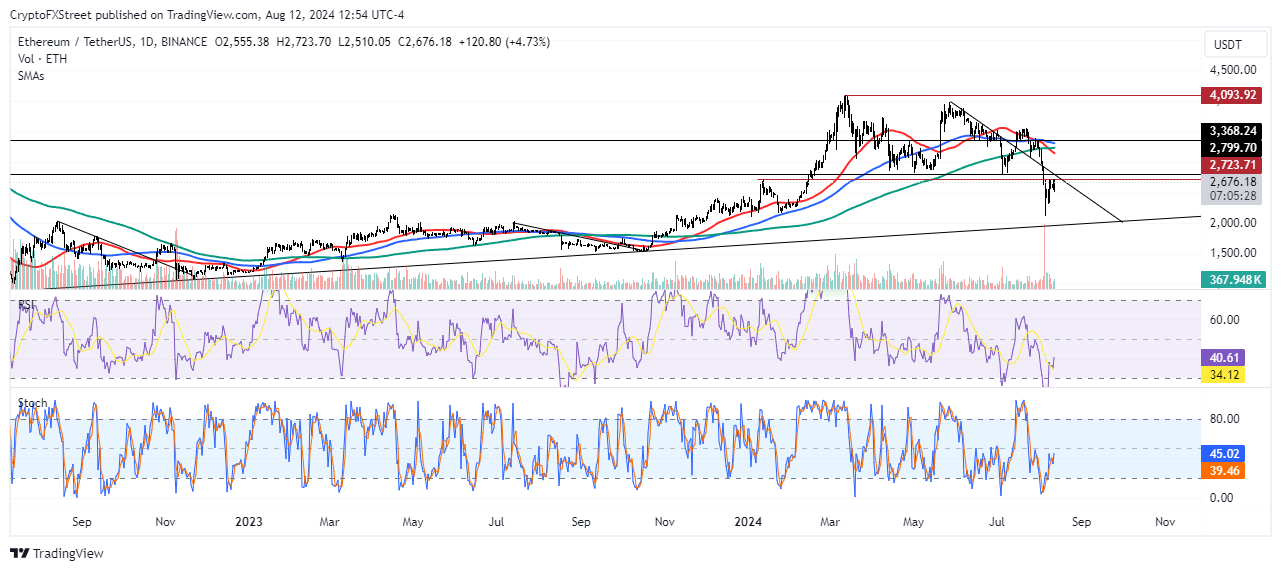- Ethereum ETFs boosted the crypto ETF landscape after recording a net inflow of $155 million last week.
- ICO-era Ethereum wallet transfers an additional 5K ETH to OKX, extending his potential sale to $154 million.
- Ethereum could rally by 20% but faces key trendline hurdle amid retest of crucial resistance level.
Ethereum (ETH) is up 1% on Monday and is looking set for a 20% rally following buying momentum from traditional investors across ETH ETFs. However, it faces potential bearish pressure from a likely dump by an old whale and resistance around a key trendline.
Daily digest market movers: Ethereum ETFs, whale dump, buy signal in on-chain metrics
Ethereum ETFs globally saw a net inflow of $155 million last week, the highest among all digital assets, based on CoinShares’ data. The ETH ETF inflows indicate that traditional investors capitalized on the market correction last week to scoop up ETH at lower prices.
Notably, BlackRock’s iShares Ethereum ETF (ETHA) is on the way to hit $1 billion in cumulative net inflows after crossing $900 million last week.
With outflows from Grayscale’s ETHE slowing down and the wider market recovering, ETH ETFs could positively impact ETH’s price in the coming weeks.
However, a few old whales are still shedding their holdings and may cause short-term bearish pressure. According to Lookonchain’s data, an Ethereum whale deposited 5,000 ETH worth $13.2 million to the OKX exchange in the past few hours. The whale has been depositing ETH to OKX since July, potentially selling 48,500 ETH worth $154 million.
The whale received 1 million ETH at $0.31 during Ethereum’s ICO and currently holds 303.5K ETH across two wallets.
Meanwhile, Ethereum’s 30-day Market Value to Realized Value (MVRV) Ratio shows that all investors who bought ETH within the last 30 days experienced an average loss of 9%. ETH’s Weighted Sentiment is also down at -0.2%, indicating a slight negative or low sentiment toward the top altcoin. These on-chain metrics show that ETH may still be in the buy zone in case of a rally.
ETH MVRV & Weighted Sentiment
ETH technical analysis: Ethereum has potential for 20% rally but faces key trendline hurdle
Ethereum is trading around $2,660 on Monday, up over 1% on the day. In the past 24 hours, ETH has seen $55.71 million in liquidations, with long and short liquidations accounting for $35.09 million and $20.62 million, respectively.
ETH is attempting to break above the $3,723 resistance, a level it has rejected twice in the past week. This resistance level intersects with a trendline that suggests ETH could decline to a swing low around the $2,020 price. As the chart below reveals, ETH has posted similar moves from August 2022 to November 2022 and July 2023 to October 2023.
ETH/USDT Daily chart
However, the Relative Strength Index (RSI) at 41 and crossing above its moving averages suggests ETH is seeing increased bullish momentum. This is also evident in the Stochastic Oscillator (Stoch), where the %K line crossed above the %D line again on Sunday. Such a move in the Stoch indicates that the momentum is shifting in favor of buyers.
The potential bullish momentum is strengthened by ETH’s futures open interest (OI) increasing over 4% to nearly $11 billion and the ETH Long/Short Ratio rising to 1.01. Rising OI when the price attempts a comeback often indicates potential for further growth.
As a result, ETH could rally over 20% to around $3,368, where it faces a key resistance. The 100-day Simple Moving Average (SMA) could also act as a resistance after ETH posted a “Death Cross” on Thursday when the 50-day SMA crossed below the 100-day SMA.
The thesis will be invalidated if ETH falls below the support level around $2,020, which also intersects with a key trendline.
Ethereum FAQs
Ethereum is a decentralized open-source blockchain with smart contracts functionality. Serving as the basal network for the Ether (ETH) cryptocurrency, it is the second largest crypto and largest altcoin by market capitalization. The Ethereum network is tailored for scalability, programmability, security, and decentralization, attributes that make it popular among developers.
Ethereum uses decentralized blockchain technology, where developers can build and deploy applications that are independent of the central authority. To make this easier, the network has a programming language in place, which helps users create self-executing smart contracts. A smart contract is basically a code that can be verified and allows inter-user transactions.
Staking is a process where investors grow their portfolios by locking their assets for a specified duration instead of selling them. It is used by most blockchains, especially the ones that employ Proof-of-Stake (PoS) mechanism, with users earning rewards as an incentive for committing their tokens. For most long-term cryptocurrency holders, staking is a strategy to make passive income from your assets, putting them to work in exchange for reward generation.
Ethereum transitioned from a Proof-of-Work (PoW) to a Proof-of-Stake (PoS) mechanism in an event christened “The Merge.” The transformation came as the network wanted to achieve more security, cut down on energy consumption by 99.95%, and execute new scaling solutions with a possible threshold of 100,000 transactions per second. With PoS, there are less entry barriers for miners considering the reduced energy demands.
This news is republished from another source. You can check the original article here











